Amazing colored potatoes: varieties of varieties and their beneficial properties
Many Russian breeders are developing new varieties of colored flesh potatoes. The multi-colored color of the flesh and skin of the potato is the result of the influence of natural pigment. The main advantage of colored potatoes is that they belong to dietary products.
However, not all gardeners like to experiment and are afraid to plant new crops. Therefore, we will consider in detail what are the features of colored potatoes, how it differs from the usual and whether it is worth cultivating it.
The content of the article
Description of culture
Colored potatoes have a varied flesh color... This is due to the fact that the tubers contain pigments that are responsible for a particular color. They have nothing to do with GMOs; in addition, colored potatoes have many health benefits.
Reference. The brighter the color of the potato pulp, the more anthocyanins it contains, which are beneficial to human health.
Colored potatoes are high in antioxidants... Some red tubers have a ginger flavor. Purple varieties have a more intense, sometimes nutty flavor.
The varieties with the most intense color are used for obtaining a natural food coloring.
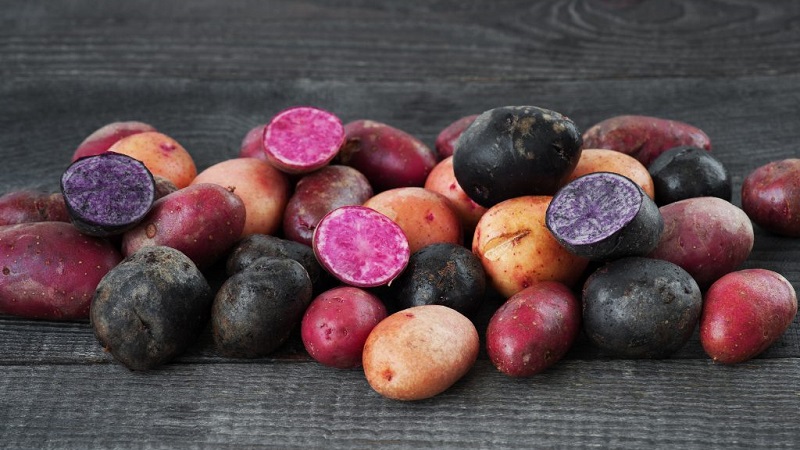
Origin and development
Colored potatoes have been known for a long time. Even before the revolution in the famous firm of the first Russian breeder E. Grachev it was possible to purchase tubers with blue and red flesh. Russian breeders started growing similar potatoes in 2007. Currently, more than 10 groups of breeders are working on the development of new varieties of such potatoes in Russia.
Varieties of varieties of colored potatoes
Breeders have developed many varieties of colored potatoes. The brightest representatives:
- All Blue - medium late grade. The tubers have a blue skin and a bright purple flesh. To maintain their color, the potatoes are not allowed to boil. The variety has a good taste.
- Borough - mid-season variety. The tubers have a bronze tint, the flesh is blue.
- Explosion (Explosion) is an early ripe variety with high yields. The color of the pulp is blue.
- All red (All red) lives up to the name, as the rind and flesh are delicate red. It tastes like a nut.
- Cranberry Red (Red cranberry) - medium early variety. The tubers are deep red, the flesh is pink with a reddish tint. The taste is fragrant, does not fade when boiled.
- Vitelotte (Vitalot) - late-ripening variety with almost black skin and purple flesh. Has a sweet nutty taste.
- Lilac - mid-season variety with purple pulp.
- Raspberry - variety with red pulp and pleasant taste. It retains its color during cooking.
- Borodyansky pink - early ripening potatoes. The tubers are round but uneven.
- Baron- early ripe potatoes with yellow skin, reddish eyes and light creamy flesh.
What determines the color of the pulp
Colored potatoes contain plant glycosides - anthocyanins... These are natural pigments that are present in some plants in flowers, stems, leaves, roots, fruits and seeds: in blue grapes, cranberries, blueberries, black currants, etc.
Attention! In order for the pulp to retain its color when boiled, colored potatoes are not peeled, but boiled in their uniform.
Chemical composition, trace elements and vitamins
Colored potatoes have a high content of proteins, carbohydrates, vitamins, micro- and macroelements.
Vitamin content in 100 g of raw potatoes:
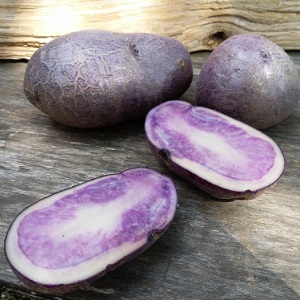 A - 2.9 μg;
A - 2.9 μg;- B1 - 0.14 mg;
- B2 - 0.63 mg;
- B5 - 0.35 mg;
- B6 - 0.34 mg;
- B9 - 0.75 mg;
- C - 21 mg;
- E - 0.11 mg;
- PP - 1.4 mg;
- beta-carotene - 0.02 mg.
Macronutrients:
- calcium - 11 mg;
- magnesium - 22 mg;
- sodium - 4.8 mg;
- potassium - 560 mg;
- phosphorus - 56 mg;
- sulfur - 31 mg;
- chlorine - 46 mg.
Trace elements:
- iron - 0.91 mg;
- zinc - 0.31 mg;
- iodine - 5.1 mcg;
- copper - 136 mcg;
- manganese - 0.16 mg;
- fluorine - 27 mcg;
- boron - 116 mcg;
- aluminum - 850 mcg.
Calorie content - 78 kcal.
Nutritional value of 100 g of product:
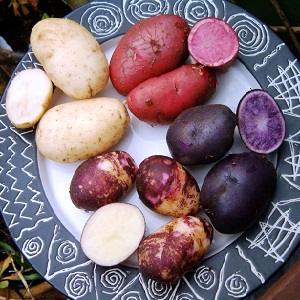 proteins - 2.3 g;
proteins - 2.3 g;- fats - 0.4 g;
- carbohydrates - 16 g;
- starch - 15 g;
- ash - 1 mg;
- water - 78 g;
- dietary fiber - 1.45 g;
- organic acids - 0.24 g
Ripening period
Colored potatoes have different ripening times, since among the variety of varieties there are early maturing, mid-maturing, mid-late and late-maturing varieties.
Yield
Since biologists are faced with the task of developing varieties of better quality, less attention is paid to increasing yields, therefore, colored varieties of crops mostly have average yields - 110-320 c / ha. But, for example, Ukrainian Krasnyakotny and Violet Krasavets are distinguished by high productivity.
Disease resistance
The main problem that arises when growing colored potatoes is low plant immunity... Basically, the varieties have an average resistance to late blight. But, for example, the Exotic variety has good resistance to common crop diseases.
Characteristics of tubers and bushes
Bushes of varicolored varieties of medium height, erect... Leaves toothed, large, medium-sized flowers. The average weight of tubers is 90-120 g. The varieties are characterized by an unusual taste, with a nutty flavor and hints of ginger.
Growing regions and climate requirements
Multicolored varieties grow well in all regions of Russia, but the best yield results were achieved in the Central, Volgo-Vyatka, southern regions of Russia. The exception is the northern regions of the country with short summers.
Advantages and disadvantages
Advantages of colored varieties:
- recognized as a dietary product;
- allowed for nutrition for diabetics;
- high content of antioxidants in tubers;
- the glycosides contained in tubers slow down the aging process of the body, prevent the spread of infections;
- anthocyanins in tubers block the formation of cancer cells;
- pleasant taste.
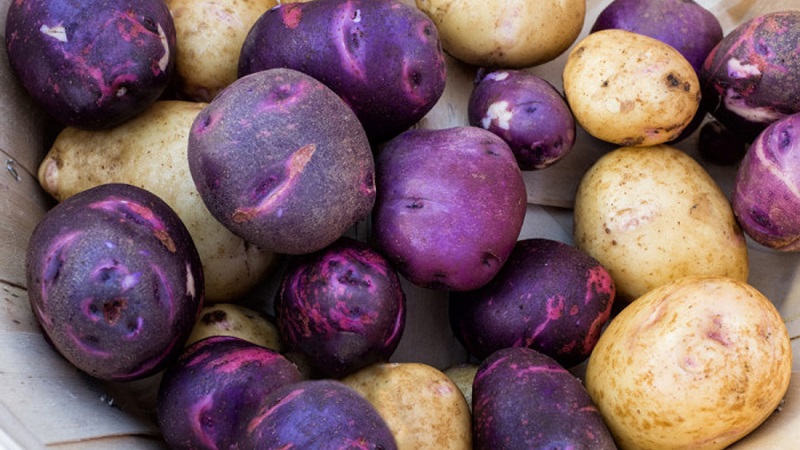
The disadvantages of multi-colored potatoes are:
- more difficult cultivation compared to regular potatoes;
- long ripening period;
- average yield indicators;
- low immunity;
- high price.
Difference from other varieties
Colored potatoes differ from ordinary varieties:
- varied pulp color;
- eating potatoes does not affect blood sugar levels;
- less resistant to low temperatures;
- not grown commercially.
Benefits for the human body
Colored potatoes are famous not only for their unusual appearance, but also for their beneficial properties. carotenoids contained in tubers. It also contains vegetable glycosides (these substances color the pulp of mulberries, blueberries, eggplant peels) - these are antioxidants that slow down the aging process of the body. And anthocyanins prevents the development of various infections and malignant tumors.
Features of planting and growing
Colored potato varieties are more demanding to comply with the rules of agricultural technology... The yield of these varieties depends on the composition of the soil - it must be fertile and breathable. Varieties do not tolerate high temperatures and lack of moisture.
Presowing preparation
Seed material must be prepared 30-40 days before planting... To do this, select healthy medium-sized tubers with developed eyes and germinate them in boxes, laying them in two layers. Before germination, the planting material is kept for 30 minutes in a solution of "Fitosporin" or boric acid (1 g per 10 l of water) to prevent the occurrence of fungal infections during the growing season.
Important! Since the colored varieties have an average resistance to diseases, it is imperative to disinfect the tubers.
As soon as the sprouts on the tubers reach 1.5 cm, they begin planting in open ground.
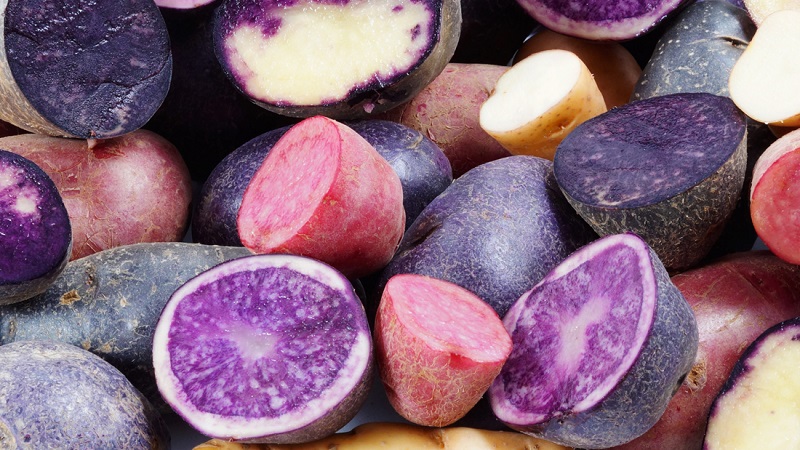
Ground requirements
Colored potatoes grow best on light, medium loamy, sandy loam, sod-podzolic and chernozem soils. Much attention is paid to soil disinfection.
Timing, scheme and landing rules
Prepared tubers are planted at the end of May, as soon as the topsoil 10-12 cm thick warms up to + 10 ° С. Planting times differ in different areas and depend on the onset of heat in the region.
For potato plantings, a well-lit area is allocated. In early May, the soil is dug up, adding charcoal and urea.
The wells are placed at a distance of 30 cm from each other... A distance of 65-70 cm is maintained between the beds. 50 g of compost is poured into each hole 10 cm deep and the sprouted tubers are carefully placed without damaging the fragile sprouts. Sprinkle with loose earth on top. With a significant drop in temperature at night, the beds are first covered with foil.
The nuances of care
The soil for growing must be nutritious, therefore, in the fall, with deep digging for every 1 sq. m make 30 g "Nitroammofoski" and 0.5 kg of humus or cow dung.
All weeds and plant residues are removed from the site.
Colored varieties are recommended to be planted away from the usualto prevent over-pollination.
Some colored varieties have tall, powerful tops. These plants require constant hilling.
During cultivation, it is necessary to monitor temperature changes... Higher or lower temperatures lead to lower yields.
Attention! Return frosts are especially dangerous for colored potatoes.
Lowering the night temperature to -3 ° C has a detrimental effect on young seedlings.
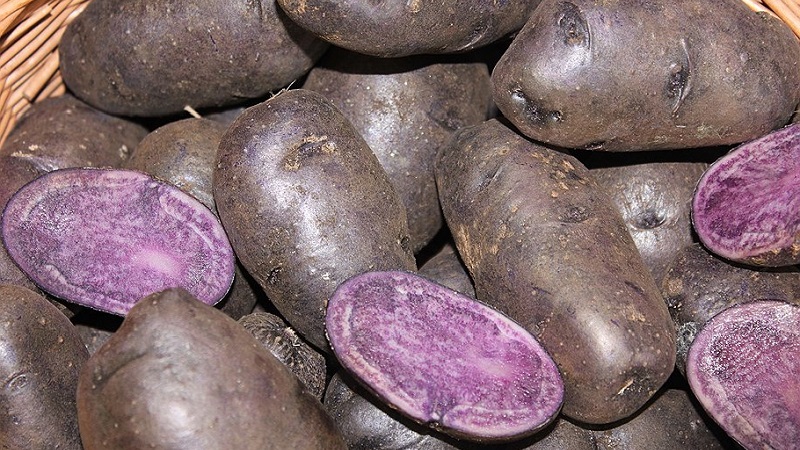
Watering mode
Colored potatoes are more hygrophilous compared to conventional varieties. For growth and development, it needs soil moisture of 70-75%.
First watering carried out when the seedlings reach 7-8 cm in height. Watered with warm water in small portions, while consuming 1.5-2 liters of water for each plant.
Before flowering the bushes are watered every 7-8 days, depending on the drying out of the soil. Sandy soil is moistened more often than sod soil.
During flowering and tuber formation plants require more moisture. During this period, 8-10 liters of water are consumed for each bush. Watering is carried out every 3 days in the morning or in the evening.
Reference. To prevent tubers from eroding from the soil with a large amount of water, it is advisable to carry out drip irrigation.
At the end of flowering the volume of the introduced liquid is increased to 12-15 liters.
Last watering carried out when the lower leaves of the tops begin to dry out.
Top dressing
At the beginning of the growing season, nitrogen fertilizers are applied: 10 g of ammonium nitrate and 10 g of ammonium sulfate per 10 liters of water. Alternate with organic matter: 50 g of humus per 10 liters of water. At the beginning of flowering, superphosphate and ammonium nitrate are added at the rate of 20 g of each fertilizer per 10 liters of water.
After the end of flowering, they are fed with a composition containing boron to improve the quality of tubers: 5 g of boric acid per 10 liters of water.
Weeding and hilling
During the entire growth of the crop, it is necessary to constantly remove weeds.... Weeds grow ahead of potato bushes and reduce the amount of nutrients in the soil. While weeding the beds, the soil is simultaneously loosened, providing air access to the roots.
When loosening the beds, the bushes are huddled, raking up the earth to the stems and creating an embankment, which helps to maintain the tops in an upright position.
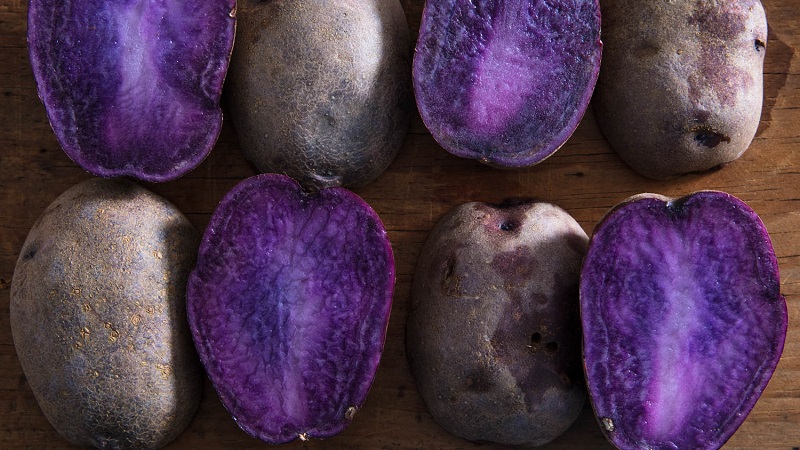
Disease and pest control
Colored potato varieties have low immunity against crop diseases... Most often potatoes affects late blight... The first sign of the disease is the appearance of dark spots on the tops. The disease quickly spreads to the tubers, the process of decay begins in them.
When the first signs of the disease appear, apply composition of potassium permanganate, copper sulfate and boric acid, taken in 5 g and dissolved in 10 liters of water. The solution is sprayed onto the tops and poured under the root. With further spread of the lesion, the bushes are treated with fungicides "Gamair" and "Oksikhom". The preparations are diluted at the rate of 15-20 ml per 10 l of water and the soil around the plants is treated.
Fusarium is a fungal disease of culture... A fungus appears in the stems, clogging the vessels and inhibiting the movement of the juice. The tops turn yellow and wither. With Fusarium, the tubers stop growing. The affected bushes are treated with Trichoderma Veride at the rate of 50 ml per 10 liters of water.
Colored potatoes may be attacked Colorado potato beetlefeeding on all the above-ground parts of the bush. To destroy it, use insecticides "Iskra" and "Commander": 2 ml of the drug is diluted in 10 liters of water to spray the bushes.
In potato plantations often appears wirewormfeeding on the pulp of tubers. To get rid of the pest, green manures are planted between the rows, and the soil is treated with Topaz fungicide: 2 ml per 10 liters of water.
Growing difficulties
When growing colored varieties, considerthat they cannot tolerate late frosts, therefore, when the temperature drops, covering material is used.
Many varieties have high, spreading tops, so they need regular hilling to keep the bushes upright.
Harvesting and storage
Different varieties of colored potatoes have different ripening times... The early ones begin to dig up in early September, the late ones - at the end of September.
Harvesting is carried out in dry weather, since after rains, wet soil is difficult to dig and tubers can be damaged.
The dug potatoes are dried, spread out in one layer on a dry surface, sorted and placed for storage.
How and when to collect
The harvesting of potatoes begins after the tops turn yellow... The bushes are dug in with a pitchfork and removed from the ground, holding by the tops. The tubers are shaken off the soil and sorted out. The damaged ones are sent for processing, the whole and healthy ones are laid out to dry in the shade.
Storage features and keeping quality
Early maturing varieties are not suitable for long-term storage, so they immediately go to cooking. Late-ripening varieties, such as Vitalot and Ves Krasny, are distinguished by good keeping quality (95%) and are stored during the winter.
Attention! Potatoes of different shades must be stored in separate boxes.
A suitable microclimate is created in the vegetable storage with air temperature + 3… + 5 ° С, humidity 85-90% and constant air circulation. Under such conditions, multi-colored potatoes are stored 6-8 months.
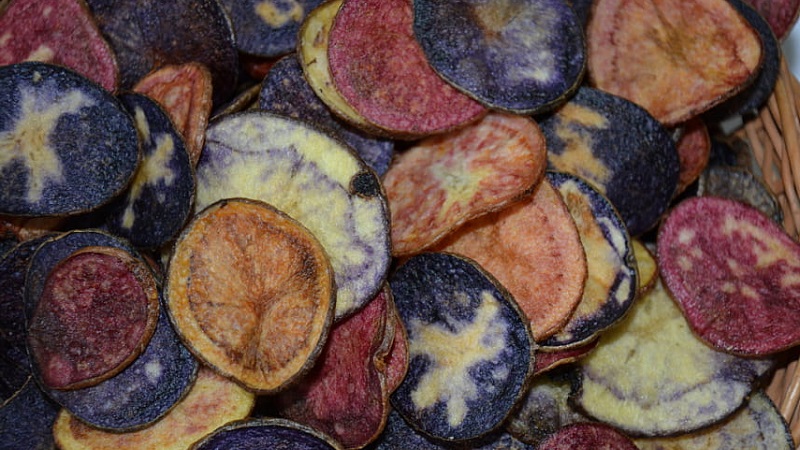
Tips from experienced gardeners
Gardeners, based on their own experience, have found that multicolored tubers are not suitable for replanting, the harvest from last year's tubers will be smaller. For planting, it is better to purchase seeds from garden centers.
Purple varieties have tall tops with thick stems, therefore, it is recommended to plant such potatoes at a great distance from each other, leaving at least 45-50 cm between the bushes.
To preserve the color of the pulp boil potatoes in salted water for no more than 20 minutes.
Reviews of varieties of colored potatoes
Reviews of colored potato varieties are mostly positive.
Olga, Yaroslavl: “I liked the characteristics and photos of the Favorit potato variety. I decided to try it, it turned out to be very tasty. Especially good for mashed potatoes - it turns out just airy ".
Victoria, Omsk: “I planted two varieties - Red Wonder and All Blue. The seed potatoes I bought turned out to be exactly the same as in the description. When growing, I did not make much effort. I liked the harvest. Red tubers have a normal taste. All blue did not change color during frying, the taste is pleasant ".
Natalia, Moscow: “I have been suffering from diabetes for a long time. I read the description of the Lord of the Expanse potato variety. From a friend I learned that colored potatoes can be eaten without restrictions. I tried to grow it on my site. The potatoes made me happy with the harvest. I really liked the taste of the white potatoes with pink eyes ".
Conclusion
Colored potatoes are becoming more and more popular in many countries. Breeders are constantly improving the taste and increasing the immunity of the crop to diseases. The beneficial properties of colored varieties are well known. A growing number of fans of unusual varieties of crops are appearing among farmers.